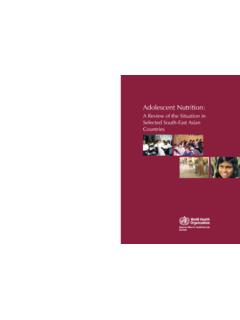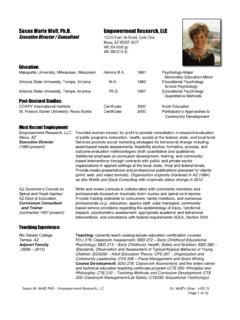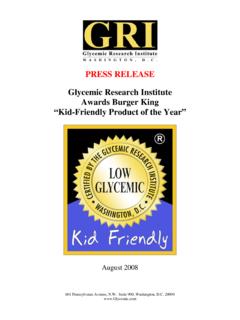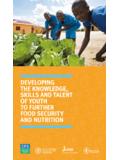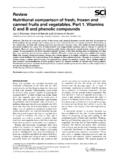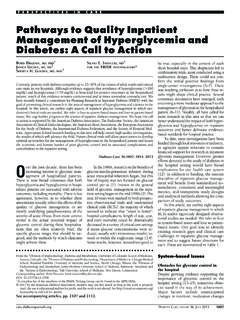Transcription of Traditional Plant Knowledge of the Tsimshian Curriculum ...
1 Traditional Plant Knowledge of the Tsimshian Curriculum : Keeping Knowledge in the Community1. _. Edo sdi/Judith C. Thompson Prince Rupert, British Columbia Who _I am and where I come _ from _ _ _. Dzenes hoti'e. Tsedze susahts'an. Edosdi ushye. Good _ afternoon. My name is Judy Thompson and my Tahltan name is Edosdi. Robert Quock, a Tahltan Elder, told me that it means someone who raises up pets and children. This name is very appropriate as I love animals and children and I am a teacher. It is very important as a First Nations person to tell who you are and where you are from. My button blanket does that.
2 I am Didene (Tahltan). and my clan is Tseskiye (crow). My crest is Tehkahche (frog), which shows that my grandmother's _ people are from the Tl'apanotine territory near Luwe Chon (Iskut, BC). My mother and grandparents are from Tlegohin (Telegraph Creek, BC). _. Edosdi's educational background My formal Euro-Canadian education began at the age of four. I attended public school for 13 years and then graduated from high school. I then completed a Bachelor of Science degree as well as a professional teaching certificate. Currently, I am working on a Master of Science degree in Environmental Studies at the University of Victoria.
3 My Master's research has involved my working with Gitga'at people in the Tsimshian community of Hartley Bay. The Traditional Plant Knowledge of the Tsimshian Curriculum that I developed for the Forests for the Future project has been adapted to be used in a high school classroom in the Hartley Bay School. This Curriculum is being used as a method, a way for students to learn about their people's ways of knowing, and to be involved in the intergenerational transmission of Traditional ecological Knowledge and wisdom. I will assess and evaluate the usefulness of incorporating culturally relevant ways of bringing Indigenous Knowledge into school science curricula.
4 My true education started about 15 years ago when I started learning from my grandparents and other Tahltan Elders about who I am as a Tahltan. My Euro-Canadian and Tahltan educations have shaped who I. am and have guided me to the career and educational paths I have chosen. I have four roles in my life. I am a student, a teacher, a Curriculum developer, and a researcher. Overall, I see myself as a Tahltan woman who 61. Canadian Journal of Native Education Volume 28 Numbers 1 and 2. is a learner and an educator. My responsibilities are to learn my people's way of knowing, our language, our Traditional ecological Knowledge (TEK), and to find ways of passing on this Knowledge and wisdom to present and future generations.
5 Using the skills associated with each of my various roles, I want to find ways of bringing Indigenous Knowledge into Curriculum that is both meaningful and relevant. It is in my capacity as a Curriculum developer that I want to find ways to bring TEK into school science Curriculum . I believe this is one way we can make science more relevant and accessible for our children. In addition, I want to discover effective ways of passing on our Knowledge to our children and to share with students the ways that our people learn and the ways in which Knowledge and wisdom were transmitted between generations.
6 I want to use this information in our schools because I find that the way we are teaching science does not seem to be working as effectively as it could be. Building Relationships with First Nations communities When working within a First Nations community as a researcher and/or as a Curriculum developer, it is important to build a strong working relationship and partnership and to be respectful, honest and sincere. It is also important to balance the ethical protocols of the academic world with that of cultural protocols of First Nations communities. In regards to both Tsimshian and Tahltan communities, I will carrying out what Maori scholar Linda Tuhiwai Smith (1999) refers to as Insider/Outsider Re- search.
7 While most research methodologies have assumed that the re- searcher is an outsider able to observe objectively, Smith states that, Indigenous research approaches problematize the insider model in dif- ferent ways because there are multiple ways of both being an insider and outsider in indigenous contexts (p. 137). In regards to working with the communities of Gitxaala and Hartley Bay, I am an outsider, even though I. am First Nations, have grown up on Tsimshian territory, and have either gone to school with, have been a teacher of, or have friendships with many Gitxaala and Hartley Bay people.
8 I have visited and/or worked with classes at the schools in Hartley Bay and Gitxaala and I am also a First Nations role model for the School District No. 52 role model program. Overall, I have been building relationships with Tsimshian communities and Tsimshian people for most of my life. My relationship with Telegraph Creek and Iskut is much more com- plex. My mother and my maternal grandparents were born and raised in Telegraph Creek, and my grandmother's people are from Tlepanotine, near Iskut, BC. I have been returning to my peoples' homeland for over a decade, and have slowly built a relationship with my people.
9 I realize that I am still an outsider on many levels, and so I have tried to be what Smith (1999) has called the seen face,' which conveys the sense that being seen by the people showing your face, turning up at important cultural events cements your membership within a community in an ongoing 62. Keeping Knowledge in the Community Thompson way and is part of how one's credibility is continually developed and maintained (p. 15). Even though I am First Nations I cannot just show up in a First Nations community and say, Here I am. I am going to do research. Even in my own Tahltan communities, I must build up that trust.
10 The Responsibility of Returning Knowledge and Results to Communities Members of First Nations communities understand the importance of being part of a community prior to commencing research with a com- munity. First Nations people have often felt that academic researchers, especially non-Aboriginal, have taken advantage of them by taking their Knowledge and then leaving without giving anything back to the com- munity. Here is a really important quote from one of my Tahltan Elders, Loveman Nole, in which he is talking about a conversation he had with a non-Aboriginal researcher who was working in Iskut.
